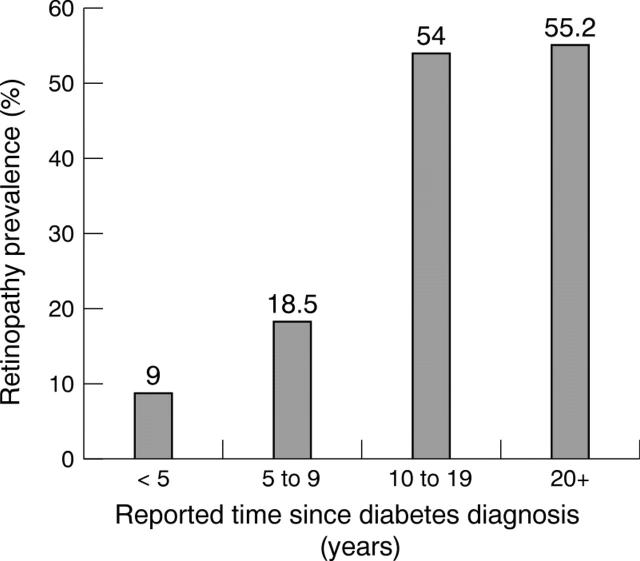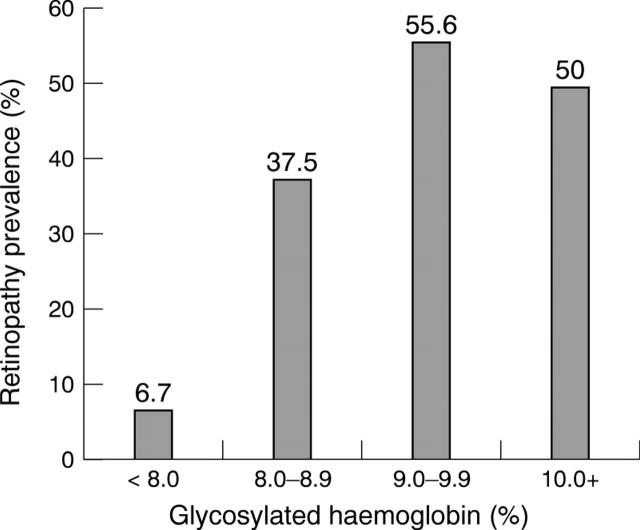Abstract
AIM—To establish the prevalence, severity, and risk factors for diabetic retinopathy in a representative sample of Victorian residents aged 40 years and older. METHODS—A population based, cluster sampling method was used to recruit 4744 participants (86% participation rate). Nine randomly selected, suburban Melbourne clusters and four randomly selected, rural Victorian clusters were used. Participants provided a detailed medical and personal history and underwent an ocular examination including funduscopy and fundus photography. Rural participants provided a blood sample, from which the glycosylated haemoglobin percentage was measured. The diagnosis of diabetic retinopathy was based on fundus photographs from participants with self reported diabetes. RESULTS—The prevalence of diabetic retinopathy among people with self reported diabetes was 29.1%. The prevalence of untreated, vision threatening retinopathy was 2.8%. Retinopathy was positively associated with a longer reported duration of diabetes diagnosis (p<0.01) and with higher fractions of glycosylated haemoglobin (p<0.01). Retinopathy was not significantly associated with age, ethnicity, body mass index, glaucoma, myopia or intake of alcohol, tobacco, or aspirin (all p > 0.05). CONCLUSIONS—Most people in Victoria with proliferative diabetic retinopathy or clinically significant macular oedema have received laser treatment. There remains however, a small but important group who have not received treatment and whose vision is threatened. People with diabetes should be encouraged to maintain strict glycaemic control and to undergo regular screening to delay or prevent the development of retinopathy.
Full Text
The Full Text of this article is available as a PDF (118.4 KB).
Figure 1 .
Prevalence of retinopathy by reported duration of diabetes diagnosis.
Figure 2 .
Prevalence of retinopathy by glycosylated haemoglobin level.
Selected References
These references are in PubMed. This may not be the complete list of references from this article.
- Ballard D. J., Melton L. J., 3rd, Dwyer M. S., Trautmann J. C., Chu C. P., O'Fallon W. M., Palumbo P. J. Risk factors for diabetic retinopathy: a population-based study in Rochester, Minnesota. Diabetes Care. 1986 Jul-Aug;9(4):334–342. doi: 10.2337/diacare.9.4.334. [DOI] [PubMed] [Google Scholar]
- Davis M. D., Fisher M. R., Gangnon R. E., Barton F., Aiello L. M., Chew E. Y., Ferris F. L., 3rd, Knatterud G. L. Risk factors for high-risk proliferative diabetic retinopathy and severe visual loss: Early Treatment Diabetic Retinopathy Study Report #18. Invest Ophthalmol Vis Sci. 1998 Feb;39(2):233–252. [PubMed] [Google Scholar]
- Dickson P. R., McCarty C. A., Keeffe J. E., Baxter R., Harper C. A., Taylor H. R. Diabetic retinopathy: examination practices and referral patterns of general practitioners. Med J Aust. 1996 Mar 18;164(6):341–344. doi: 10.5694/j.1326-5377.1996.tb122049.x. [DOI] [PubMed] [Google Scholar]
- Kingsley L. A., Dorman J. S., Doft B. H., Orchard T. J., LaPorte R. E., Kuller L. H., Drash A. L. An epidemiologic approach to the study of retinopathy: the Pittsburgh diabetic morbidity and retinopathy studies. Diabetes Res Clin Pract. 1988 Jan 7;4(2):99–109. doi: 10.1016/s0168-8227(88)80004-4. [DOI] [PubMed] [Google Scholar]
- Klein R., Klein B. E., Moss S. E., Davis M. D., DeMets D. L. Glycosylated hemoglobin predicts the incidence and progression of diabetic retinopathy. JAMA. 1988 Nov 18;260(19):2864–2871. [PubMed] [Google Scholar]
- Klein R., Klein B. E., Moss S. E., Davis M. D., DeMets D. L. The Wisconsin Epidemiologic Study of Diabetic Retinopathy. VII. Diabetic nonproliferative retinal lesions. Ophthalmology. 1987 Nov;94(11):1389–1400. doi: 10.1016/s0161-6420(87)33275-0. [DOI] [PubMed] [Google Scholar]
- Klein R., Klein B. E., Moss S. E., Davis M. D., DeMets D. L. The Wisconsin epidemiologic study of diabetic retinopathy. III. Prevalence and risk of diabetic retinopathy when age at diagnosis is 30 or more years. Arch Ophthalmol. 1984 Apr;102(4):527–532. doi: 10.1001/archopht.1984.01040030405011. [DOI] [PubMed] [Google Scholar]
- Klein R., Klein B. E., Moss S. E., Davis M. D., DeMets D. L. The Wisconsin epidemiologic study of diabetic retinopathy. IV. Diabetic macular edema. Ophthalmology. 1984 Dec;91(12):1464–1474. doi: 10.1016/s0161-6420(84)34102-1. [DOI] [PubMed] [Google Scholar]
- Klein R., Klein B. E., Moss S. E. Epidemiology of proliferative diabetic retinopathy. Diabetes Care. 1992 Dec;15(12):1875–1891. doi: 10.2337/diacare.15.12.1875. [DOI] [PubMed] [Google Scholar]
- Klein R., Klein B. E., Moss S. E., Linton K. L. The Beaver Dam Eye Study. Retinopathy in adults with newly discovered and previously diagnosed diabetes mellitus. Ophthalmology. 1992 Jan;99(1):58–62. doi: 10.1016/s0161-6420(92)32011-1. [DOI] [PubMed] [Google Scholar]
- Livingston P. M., Carson C. A., Stanislavsky Y. L., Lee S. E., Guest C. S., Taylor H. R. Methods for a population-based study of eye disease: the Melbourne Visual Impairment Project. Ophthalmic Epidemiol. 1994 Dec;1(3):139–148. doi: 10.3109/09286589409047222. [DOI] [PubMed] [Google Scholar]
- Livingston P. M., Lee S. E., McCarty C. A., Taylor H. R. A comparison of participants with non-participants in a population-based epidemiologic study: the Melbourne Visual Impairment Project. Ophthalmic Epidemiol. 1997 Jun;4(2):73–81. doi: 10.3109/09286589709057099. [DOI] [PubMed] [Google Scholar]
- McCarty C. A., Lloyd-Smith C. W., Lee S. E., Livingston P. M., Stanislavsky Y. L., Taylor H. R. Use of eye care services by people with diabetes: the Melbourne Visual Impairment Project. Br J Ophthalmol. 1998 Apr;82(4):410–414. doi: 10.1136/bjo.82.4.410. [DOI] [PMC free article] [PubMed] [Google Scholar]
- Mitchell P., Moffitt P. Update and implications from the Newcastle diabetic retinopathy study. Aust N Z J Ophthalmol. 1990 Feb;18(1):13–17. doi: 10.1111/j.1442-9071.1990.tb00578.x. [DOI] [PubMed] [Google Scholar]
- Mitchell P., Smith W., Wang J. J., Attebo K. Prevalence of diabetic retinopathy in an older community. The Blue Mountains Eye Study. Ophthalmology. 1998 Mar;105(3):406–411. doi: 10.1016/S0161-6420(98)93019-6. [DOI] [PubMed] [Google Scholar]
- Moss S. E., Meuer S. M., Klein R., Hubbard L. D., Brothers R. J., Klein B. E. Are seven standard photographic fields necessary for classification of diabetic retinopathy? Invest Ophthalmol Vis Sci. 1989 May;30(5):823–828. [PubMed] [Google Scholar]
- Orchard T. J., Dorman J. S., Maser R. E., Becker D. J., Drash A. L., Ellis D., LaPorte R. E., Kuller L. H. Prevalence of complications in IDDM by sex and duration. Pittsburgh Epidemiology of Diabetes Complications Study II. Diabetes. 1990 Sep;39(9):1116–1124. doi: 10.2337/diab.39.9.1116. [DOI] [PubMed] [Google Scholar]
- Stolk R. P., Vingerling J. R., de Jong P. T., Dielemans I., Hofman A., Lamberts S. W., Pols H. A., Grobbee D. E. Retinopathy, glucose, and insulin in an elderly population. The Rotterdam Study. Diabetes. 1995 Jan;44(1):11–15. doi: 10.2337/diab.44.1.11. [DOI] [PubMed] [Google Scholar]
- Warram J. H., Manson J. E., Krolewski A. S. Glycosylated hemoglobin and the risk of retinopathy in insulin-dependent diabetes mellitus. N Engl J Med. 1995 May 11;332(19):1305–1306. doi: 10.1056/NEJM199505113321915. [DOI] [PubMed] [Google Scholar]
- Wensor M. D., McCarty C. A., Stanislavsky Y. L., Livingston P. M., Taylor H. R. The prevalence of glaucoma in the Melbourne Visual Impairment Project. Ophthalmology. 1998 Apr;105(4):733–739. doi: 10.1016/S0161-6420(98)94031-3. [DOI] [PubMed] [Google Scholar]




